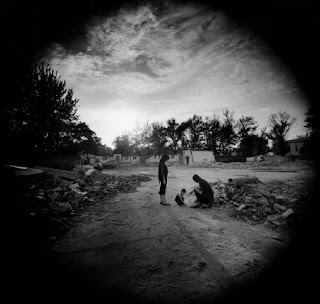Shadows were mentioned in my midterm critique in reference to my color filled figures. I had not thought of shadows before when looking at my work, but the comment sparked my interest and I think it's worth exploring.
shadow |ˈ sh adō|
noun
1 a dark area or shape produced by a body coming between rays of light and a surface : trees cast long shadows.
• partial or complete darkness, esp. as produced in this way : the north side of the cathedral was deep in shadow | ( shadows) a stranger slowly approached from the shadows.• the shaded part of a picture.
• a dark patch or area on a surface : there are dark shadows beneath your eyes.• a region of opacity on a radiograph : shadows on his lungs.
• short for eyeshadow .
2 figurative used in reference to proximity, ominous oppressiveness, or sadness and gloom : the shadow of war fell across Europe | only one shadow lay over Sally's life.
• used in reference to something insubstantial or fleeting : a freedom that was more shadow than substance.
• used in reference to a position of relative inferiority or obscurity : helived in the shadow of his father.
• [with negative ] the slightest trace of something : she knew without a shadow of a doubt that he was lying.
• a weak or inferior remnant or version of something : this fine-looking, commanding man had become a shadow of his former self.
• an expression of perplexity or sadness : a shadow crossed Maria's face.
3 an inseparable attendant or companion : her faithful shadow, a Yorkshire terrier called Heathcliffe.
• a person secretly following and observing another.
• a person who accompanies someone in their daily activities at work in order to gain experience at or insight into a job.
• [usu. as adj. ] Brit. the opposition counterpart of a government minister: the shadow Chancellor.
• [as adj. ] unofficial or alternative : the Committee of Twenty-Five, a shadow government of unelected businessmen.
Quotes:
“To think of shadows," Victor Hugo wrote in his great novel, Les Miserables, "is a serious thing.”
- Hugo, of course, was addressing vast concepts -- justice, memory, vengeance -- both in the book and in that particular quote.
"But the beauty of shadows is that they can be so many things: symbols, suggestions, riddles, jokes, threats. They can be anything, or they can simply be themselves -- which is a central reason why they're so cool."
- Life Magazine
"There are dark shadows on the earth, but its lights are stronger in the contrast."
- Charles Dickens
Annotated Bib:
Shadows: Unlocking Their Secrets, from Plato to Our Time
This book explores every aspect of the shadow from science, to history, to metaphor. It is divided into sections: The heart of the shadow, Shadows in the sky, The century of shadows, and Shadow visions. In The heart os the shadow there are sections called Shadow of the Mind, and Shadow of a Doubt, which both sounds very interesting.
‘From Six Mile Village to Three Shadows’, by RongRong and inri



















